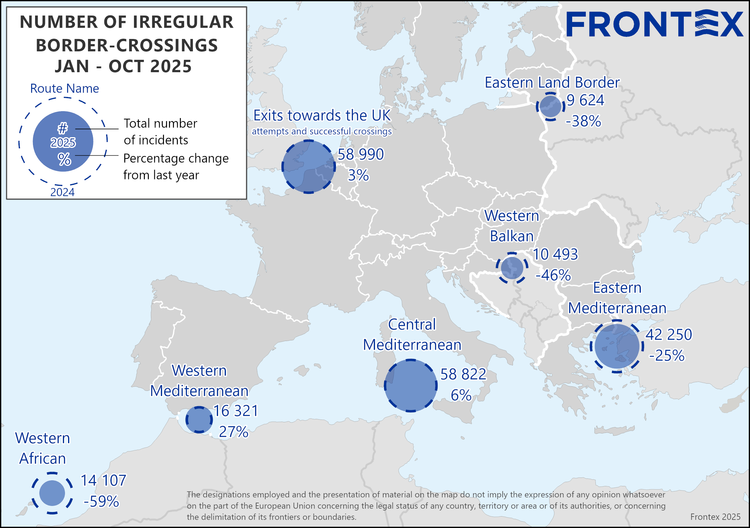Irregular entries into the
European Union dropped by 22% in the first ten months of 2025 to 152 000,
according to preliminary data from Frontex, the European Border and Coast Guard
Agency.*
More than 3 800 Frontex officers
are supporting national authorities in safeguarding the EU's external borders
across Europe.
Key highlights:
- Strong declines were recorded on the Western
African (-59%), Western Balkan (-46%), and Eastern Land Border (-38%) routes.
-
The Central Mediterranean remained the busiest
route, accounting for two of every five irregular entries into the EU this
year.
- Irregular entries on the Western Mediterranean route rose 27%.
- The most frequently reported nationalities:
Bangladeshi, Egyptian and Afghan.
In the Central Mediterranean,
nearly 59 000 arrivals were detected between January and October 2025 - broadly
in line with the same period last year. Libya remains the main departure point,
accounting for 90% of all arrivals on this route.
In the Eastern Mediterranean,
the number of irregular crossings fell by 25% to nearly 43 000. However,
activity along the Libya–Crete corridor remained high in October, with
detections increasing by 272% in the first ten months of 2025 compared to the
same period last year.
On the Western Mediterranean
route, the number of irregular crossings increased by 27%. Over 75% of migrants
departed from Algeria. The main nationalities registered on this route were
Algerian and Moroccan.
The Western African route
recorded the sharpest decline, down by 59% to just over 14 100 detections this
year. The majority of people detected on this route were nationals of Mali,
Senegal and Guinea.
Despite the overall decline, the
human cost remains devastating. According to estimates by the International
Organization for Migration, more than 1 500 people have died while
attempting to cross the Mediterranean Sea so far this year.
Crossings towards the United Kingdom via the Channel
remained largely unchanged compared with 2024, rising slightly by 3% to nearly
59 000 attempts in the first ten months of 2025.
* Note: The preliminary data
presented in this statement refer to the number of detections of irregular
border crossings at the external borders of the European Union. The same person
may be detected crossing the border several times in different locations at the
external border.

